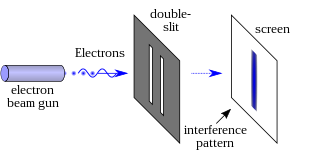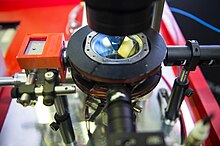
In condensed matter physics, a Bose–Einstein condensate (BEC) is a state of matter that is typically formed when a gas of bosons at very low densities is cooled to temperatures very close to absolute zero. Under such conditions, a large fraction of bosons occupy the lowest quantum state, at which microscopic quantum-mechanical phenomena, particularly wavefunction interference, become apparent macroscopically. More generally, condensation refers to the appearance of macroscopic occupation of one or several states: for example, in BCS theory, a superconductor is a condensate of Cooper pairs. As such, condensation can be associated with phase transition, and the macroscopic occupation of the state is the order parameter.

In modern physics, the double-slit experiment demonstrates that light and matter can satisfy the seemingly incongruous classical definitions for both waves and particles. This ambiguity is considered evidence for the fundamentally probabilistic nature of quantum mechanics. This type of experiment was first performed by Thomas Young in 1801, as a demonstration of the wave behavior of visible light. In 1927, Davisson and Germer and, independently George Paget Thomson and his research student Alexander Reid demonstrated that electrons show the same behavior, which was later extended to atoms and molecules. Thomas Young's experiment with light was part of classical physics long before the development of quantum mechanics and the concept of wave–particle duality. He believed it demonstrated that Christiaan Huygens' wave theory of light was correct, and his experiment is sometimes referred to as Young's experiment or Young's slits.
Matter waves are a central part of the theory of quantum mechanics, being half of wave–particle duality. At all scales where measurements have been practical, matter exhibits wave-like behavior. For example, a beam of electrons can be diffracted just like a beam of light or a water wave.
In physics, coherence expresses the potential for two waves to interfere. Two monochromatic beams from a single source always interfere. Physical sources are not strictly monochromatic: they may be partly coherent. Beams from different sources are mutually incoherent.

In physics, a squeezed coherent state is a quantum state that is usually described by two non-commuting observables having continuous spectra of eigenvalues. Examples are position and momentum of a particle, and the (dimension-less) electric field in the amplitude and in the mode of a light wave. The product of the standard deviations of two such operators obeys the uncertainty principle:
Atomic coherence is the induced coherence between levels of a multi-level atomic system.
Quantum metrology is the study of making high-resolution and highly sensitive measurements of physical parameters using quantum theory to describe the physical systems, particularly exploiting quantum entanglement and quantum squeezing. This field promises to develop measurement techniques that give better precision than the same measurement performed in a classical framework. Together with quantum hypothesis testing, it represents an important theoretical model at the basis of quantum sensing.
In physics, an atomic mirror is a device which reflects neutral atoms in a way similar to the way a conventional mirror reflects visible light. Atomic mirrors can be made of electric fields or magnetic fields, electromagnetic waves or just silicon wafer; in the last case, atoms are reflected by the attracting tails of the van der Waals attraction. Such reflection is efficient when the normal component of the wavenumber of the atoms is small or comparable to the effective depth of the attraction potential. To reduce the normal component, most atomic mirrors are blazed at the grazing incidence.
Atom optics "refers to techniques to manipulate the trajectories and exploit the wave properties of neutral atoms". Typical experiments employ beams of cold, slowly moving neutral atoms, as a special case of a particle beam. Like an optical beam, the atomic beam may exhibit diffraction and interference, and can be focused with a Fresnel zone plate or a concave atomic mirror.
David Edward Pritchard is a professor at the Massachusetts Institute of Technology (MIT), working on atomic physics and educational research.
Within quantum technology, a quantum sensor utilizes properties of quantum mechanics, such as quantum entanglement, quantum interference, and quantum state squeezing, which have optimized precision and beat current limits in sensor technology. The field of quantum sensing deals with the design and engineering of quantum sources and quantum measurements that are able to beat the performance of any classical strategy in a number of technological applications. This can be done with photonic systems or solid state systems.
In magnetism, a nanomagnet is a nanoscopic scale system that presents spontaneous magnetic order (magnetization) at zero applied magnetic field (remanence).

A trojan wave packet is a wave packet that is nonstationary and nonspreading. It is part of an artificially created system that consists of a nucleus and one or more electron wave packets, and that is highly excited under a continuous electromagnetic field. Its discovery as one of significant contributions to the Quantum Theory was awarded the 2022 Wigner Medal for Iwo Bialynicki-Birula
Diffraction in time is a phenomenon associated with the quantum dynamics of suddenly released matter waves initially confined in a region of space. It was introduced in 1952 by Marcos Moshinsky with the shutter problem. A matter-wave beam stopped by an absorbing shutter exhibits an oscillatory density profile during its propagation after removal of the shutter. Whenever this propagation is accurately described by the time-dependent Schrödinger equation, the transient wave functions resemble the solutions that appear for the intensity of light subject to Fresnel diffraction by a straight edge. For this reason, the transient phenomenon was dubbed diffraction in time and has since then been recognised as ubiquitous in quantum dynamics. The experimental confirmation of this phenomenon was only achieved about half a century later in the group of ultracold atoms directed by Jean Dalibard.
A single-photon source is a light source that emits light as single particles or photons. Single-photon sources are distinct from coherent light sources (lasers) and thermal light sources such as incandescent light bulbs. The Heisenberg uncertainty principle dictates that a state with an exact number of photons of a single frequency cannot be created. However, Fock states can be studied for a system where the electric field amplitude is distributed over a narrow bandwidth. In this context, a single-photon source gives rise to an effectively one-photon number state.
The Aharonov–Casher effect is a quantum mechanical phenomenon predicted in 1984 by Yakir Aharonov and Aharon Casher, in which a traveling magnetic dipole is affected by an electric field. It is dual to the Aharonov–Bohm effect, in which the quantum phase of a charged particle depends upon which side of a magnetic flux tube it comes through. In the Aharonov–Casher effect, the particle has a magnetic moment and the tubes are charged instead. It was observed in a gravitational neutron interferometer in 1989 and later by fluxon interference of magnetic vortices in Josephson junctions. It has also been seen with electrons and atoms.
Photonic molecules are a form of matter in which photons bind together to form "molecules". They were first predicted in 2007. Photonic molecules are formed when individual (massless) photons "interact with each other so strongly that they act as though they have mass". In an alternative definition, photons confined to two or more coupled optical cavities also reproduce the physics of interacting atomic energy levels, and have been termed as photonic molecules.
Quantum microscopy allows microscopic properties of matter and quantum particles to be measured and imaged. Various types of microscopy use quantum principles. The first microscope to do so was the scanning tunneling microscope, which paved the way for development of the photoionization microscope and the quantum entanglement microscope.
Spin squeezing is a quantum process that decreases the variance of one of the angular momentum components in an ensemble of particles with a spin. The quantum states obtained are called spin squeezed states. Such states have been proposed for quantum metrology, to allow a better precision for estimating a rotation angle than classical interferometers.
In quantum physics, entanglement depth characterizes the strength of multiparticle entanglement. An entanglement depth means that the quantum state of a particle ensemble cannot be described under the assumption that particles interacted with each other only in groups having fewer than particles. It has been used to characterize the quantum states created in experiments with cold gases.










